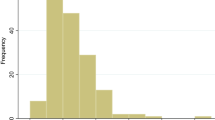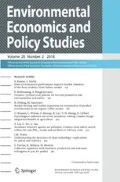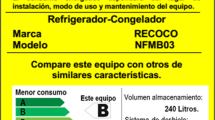Abstract
If the pattern of appliance use varies between households, then we expect that appliance replacement cycle also varies between households. Although many studies identified early adopters of new energy-efficient products, few studies have examined households that have been using old energy-inefficient products and how their characteristics are associated with product replacement. In this study, we initially modify a survival function and develop an economic model to evaluate the impact of household characteristics on appliance replacement. We subsequently apply the model in microlevel data analysis from the Survey on Carbon Dioxide Emission from Households obtained from the Ministry of the Environment of Japan. We use information about age distribution of refrigerators (REFs) and examine how family size, household income, and age of household’s head affect the replacement cycle of REFs. Our empirical results reveal that (1) large-sized, (2) high-income, and (3) young households replace REFs more rapidly. These findings suggest that policies that encourage small-sized, elderly, and low-income households to replace old appliances are needed.






Similar content being viewed by others

Notes
Detailed reasons regarding the appliance selection are discussed in Sect. 3.1.
In SCDEH 2016, REF with the largest internal volume is defined as the main REF owned by the household.
Only 10,043 out of 11,632 households answered the age of households’ head. We focus on these 10,043 households henceforth in the remaining analyses.
We further estimated these models for households with only one REF. The estimation results are similar to the results presented in Table 3. This fact implies that the ownership of REFs does not affect the impact of family size/household income/age of household’s head on the replacement cycle of the main REF.
Estimated parameters in Model 3–2 and Model 3–4 are used for the calculation, respectively.
References
Agency for Natural Resources and Energy (2017) Energy efficiency catalog. https://www.enecho.meti.go.jp/category/saving_and_new/saving/general/more/pdf/winter2017.pdf. Accessed 2 Apr 2020
Belaida F, Garcia T (2016) Understanding the spectrum of residential energy-saving behaviours: French evidence using disaggregated data. Energy Econ 57:204–214
Blasch J, Daminato C (2018) Behavioral anomalies and energy-related individual choices: the role of status-quo bias. https://doi.org/10.2139/ssrn.3289624. https://ssrn.com/abstract=3289624
Campbell AR, Ryley T, Thring R (2012) Identifying the early adopters of alternative fuel vehicles: a case study of Birmingham, United Kingdom. Transp Res Part A 46(8):1318–1327
Fernandez VP (2000) Decisions to replace consumer durables goods: an econometric application of winter and renewal processes. Rev Econ Stat 82(3):452–461
Fernandez VP (2001) Observable and unobservable determinants of replacement of home appliances. Energy Econ 23:305–323
Houde S, Aldy JE (2017) Consumers’ response to state energy efficient appliance rebate programs. Am Econ J Econ Policy 9(4):227–255. https://doi.org/10.1257/pol.20140383
Li J, Just RE (2018) Modeling household energy consumption and adoption of energy efficient technology. Energy Econ 72:404–415
Ministry of the Environment (2009) Green home appliances eco-point program. <https://www.env.go.jp/policy/ep_kaden/about/index.html. Accessed 27 Feb 2020
Ministry of the Environment (2016) Survey on carbon dioxide emission from households
Ministry of the Environment (2019) The survey on carbon dioxide emission from households. http://www.env.go.jp/earth/ondanka/ghg/kateiCO2tokei.html. Accessed 10 Oct 2020 (in Japanese)
Murray AG, Mills BF (2011) Read the label! Energy star appliance label awareness and uptake among U.S. consumers. Energy Econ 33:1103–1110
Nakano S, Washizu A (2017) Changes in consumer behavior as a result of the home appliance eco-point system: an analysis based on micro data from the Family Income and Expenditure Survey. Environ Econ Policy Stud 19(3):459–482
Office of Energy Efficiency and Renewable Energy (2015) State energy-efficient appliance rebate program: volume 2 – program results. https://www.energy.gov/eere/buildings/downloads/state-energy-efficient-appliance-rebate-program-volume-2-program-results. Accessed 21 Feb 2020
Schleich J, Gassmann X, Faure C, Meissner T (2016) Making the implicit explicit: a look inside the implicit discount rate. Energy Policy 97:321–331
Schleich J, Gassmann X, Meissner T, Faure C (2019) A large-scale test of the effects of time discounting, risk aversion, loss aversion, and present bias on household adoption of energy-efficient technologies. Energy Econ 80:377–393
United States Environmental Protection Agency (2020) About ENERGY STAR. https://www.energystar.gov/about. Accessed 23 Apr 2020
van Rijnsoever FJ, Rogier A, Donders T (2009) The effect of innovativeness on different levels of technology adoption. J Am Soc Inf Sci Technol 60(5):984–996. https://doi.org/10.1002/asi.21029
Wang J, Matsumoto S (2019) Can subsidy programs change the customer base of next generation vehicles?. RIEEM Discussion Paper Series, No. 1904
Wang J, Matsumoto S (2020) Climate policy in household sector. In: Arimura TH, Matsumoto S (eds) Carbon pricing in Japan, 3rd edn. Springer Nature, Berlin, pp 45–60
Wang J, Sugino M, Matsumoto S (2019) Determinants of household energy efficiency investment: analysis of refrigerator purchasing behavior. Int J Econ Policy Stud 13(2):389–402
Ward DO, Clark CD, Jensen KL, Yen ST, Russell CS (2011) Factors influencing willingness-to-pay for the ENERGY STAR label. Energy Policy 39(3):1450–1458
Yamaguchi K, Matsumoto S, Tasaki T (2016) Effect of an eco-point program on consumer digital TV selection. In: Matsumoto S (eds) Environmental subsidies to consumers: How did they work in the Japanese market?. Routledge, London and New York, pp 76–90
Acknowledgements
This research was supported by the Environment Research and Technology Development Fund (2-1707) of the Environmental Restoration and Conservation Agency and KAKENHI (18K01578) of the Japan Society for the Promotion of Science. This research was also supported by Aoyama Gakuin University Research Institute “Early Eagle” grant program for promotion of research by early career researchers. An earlier version of this paper was presented at the annual conference of Society of Environmental Economics and Policy Studies; we received valuable comments from Professor Isamu Matsukawa. We would also like to thank Fumihiro Goto for his accurate and helpful advices.
Author information
Authors and Affiliations
Corresponding author
Additional information
Publisher's Note
Springer Nature remains neutral with regard to jurisdictional claims in published maps and institutional affiliations.
About this article
Cite this article
Wang, J., Matsumoto, S. An economic model of home appliance replacement: application to refrigerator replacement among Japanese households. Environ Econ Policy Stud 24, 29–48 (2022). https://doi.org/10.1007/s10018-020-00295-2
Received:
Accepted:
Published:
Issue Date:
DOI: https://doi.org/10.1007/s10018-020-00295-2



